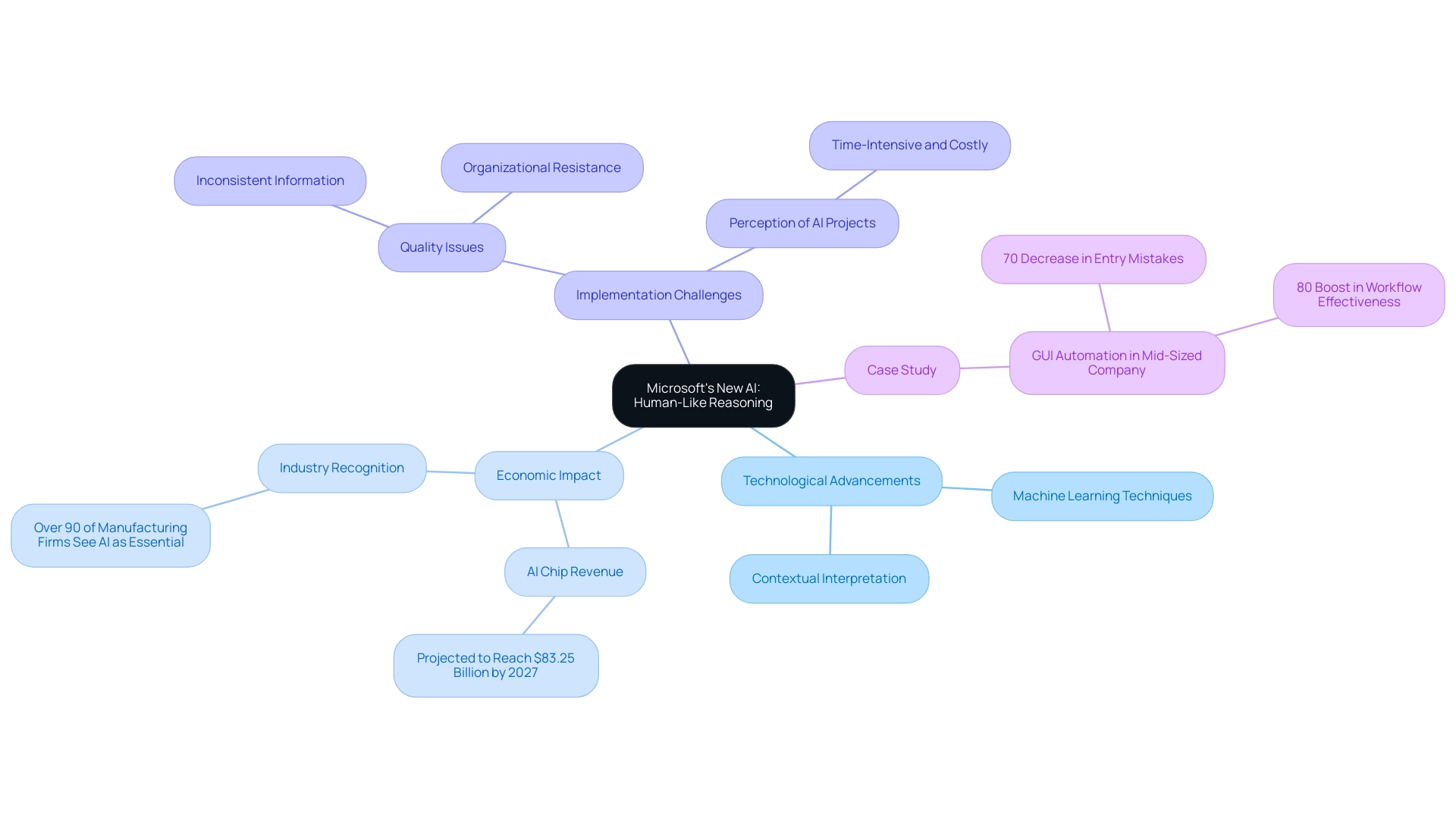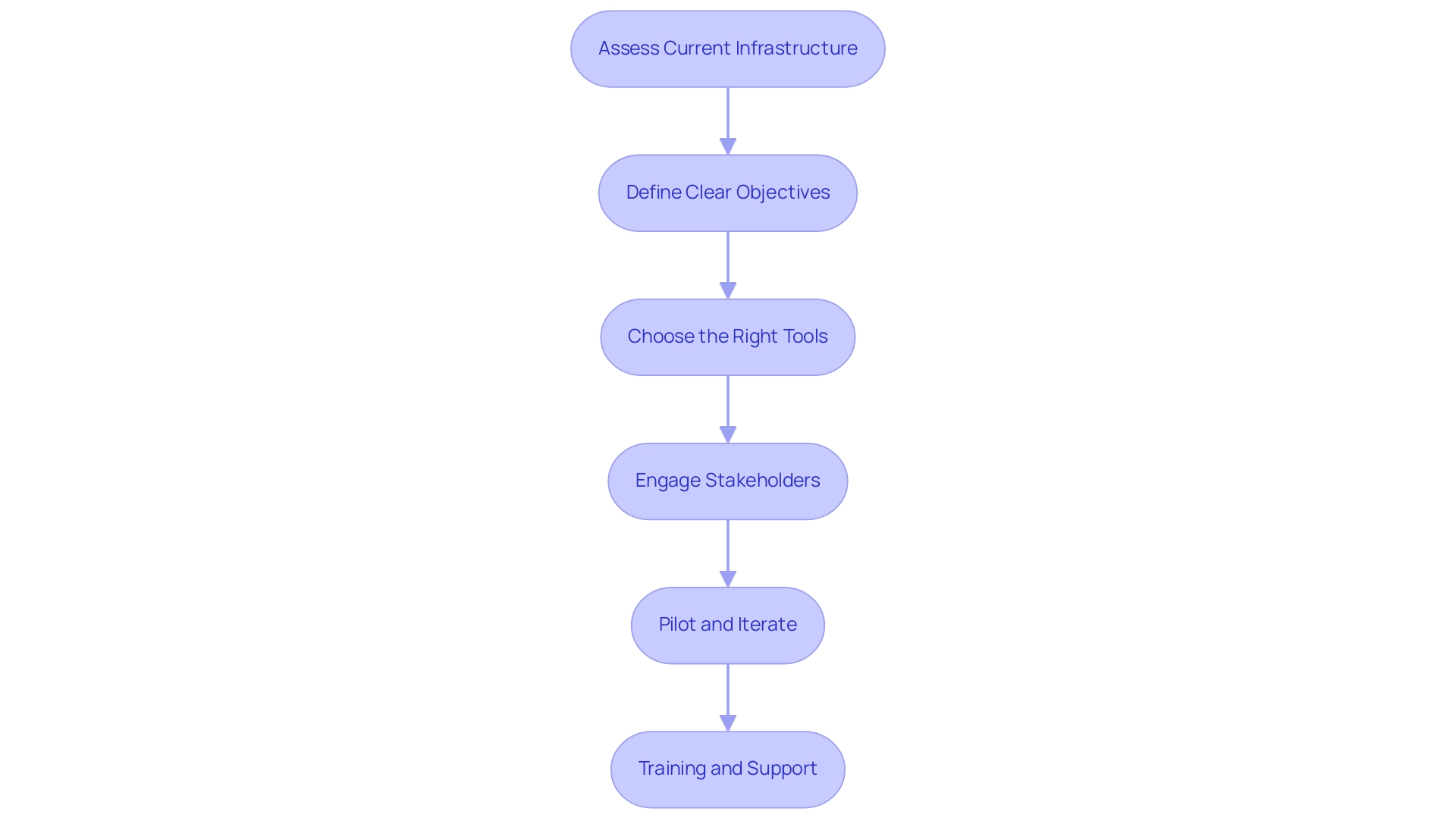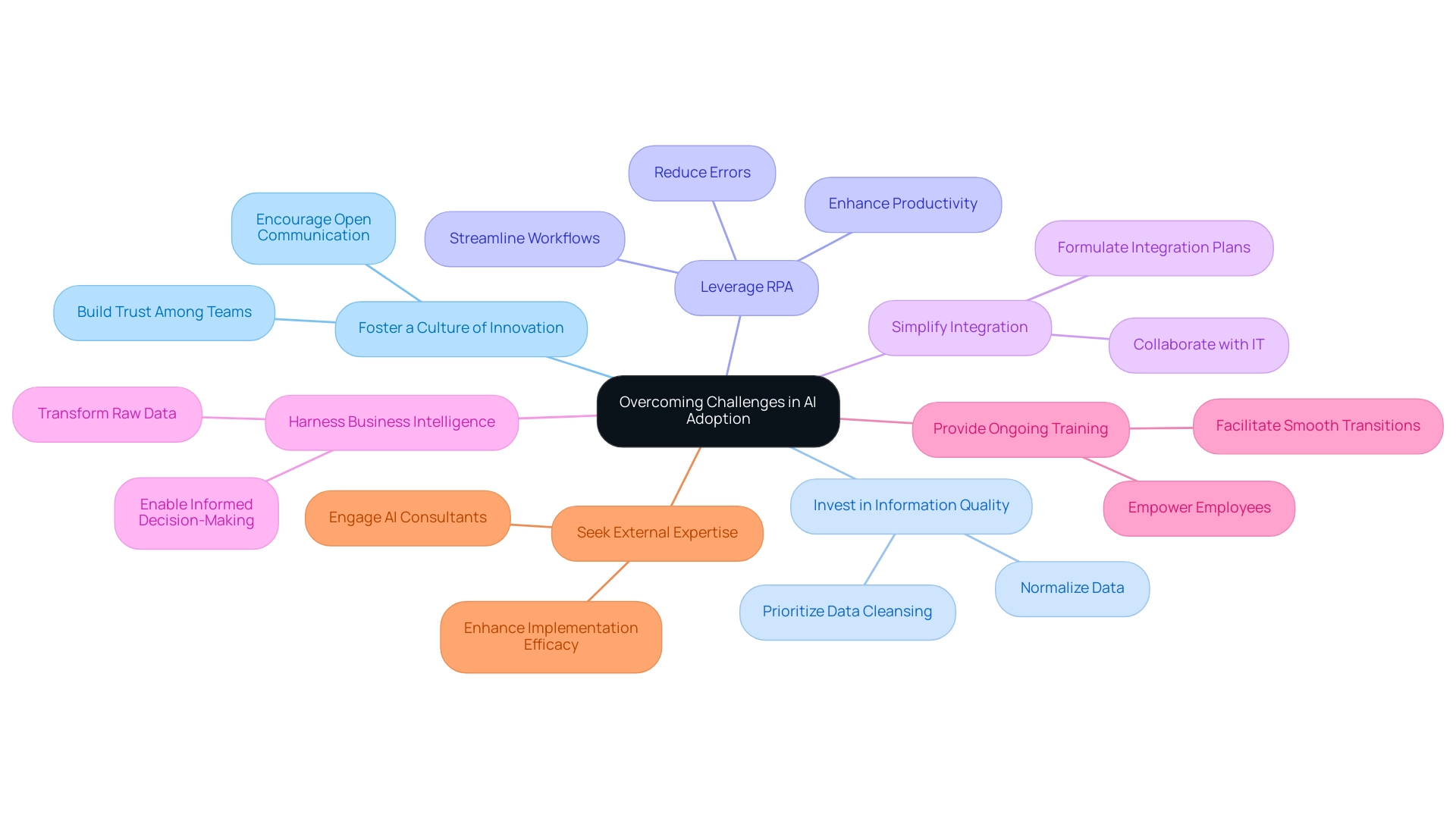Overview
Microsoft’s new AI demonstrates human-like reasoning abilities, marking a significant advancement in artificial intelligence that enhances decision-making and operational efficiency across various sectors. The article supports this by detailing how the AI utilizes sophisticated machine learning techniques to interpret context and generate responses, while also discussing the economic implications and practical applications that underscore its transformative potential in business environments.
Introduction
In the rapidly evolving landscape of artificial intelligence, Microsoft’s latest models are setting a new standard by incorporating human-like reasoning capabilities that redefine how organizations interact with technology. These advanced systems move beyond traditional AI limitations, allowing for a nuanced understanding of context and the ability to generate responses that closely mimic human thought.
As businesses increasingly recognize the transformative potential of AI, evidenced by significant investments and a surge in adoption across various sectors, the focus shifts to practical implementation strategies. From enhancing customer service to streamlining operations, the integration of AI presents both opportunities and challenges.
Organizations must navigate data quality issues and employee resistance while leveraging innovative tools to maximize efficiency and drive sustainable growth. This article delves into the multifaceted impact of Microsoft’s AI advancements, offering actionable insights for leaders aiming to harness this technology for operational excellence.
Exploring Microsoft’s New AI: An Overview of Human-Like Reasoning
Microsoft’s new AI shows signs of reasoning, signifying a pivotal advancement in artificial intelligence, particularly through their integration of human-like capabilities. These models surpass conventional AI systems, which often rely on inflexible algorithms and unchanging information sets. Instead, they utilize sophisticated machine learning techniques, enabling them to interpret context, draw inferences, and generate responses that mirror human thought processes.
This innovative method enables entities to examine extensive information points, foresee possible results, and adjust reactions in real-time—acting as a crucial resource for improving decision-making and efficiency.
A recent study reveals that over 90% of manufacturing firms regard AI as essential to their strategic objectives, emphasizing the growing recognition of AI’s transformative potential. The projected growth in global AI chip revenue, expected to reach $83.25 billion by 2027, further underscores the economic implications of these advancements. Moreover, the rapid rise in FDA-approved AI-related medical devices—surging more than 45-fold since 2012—demonstrates AI’s extensive impact across diverse sectors.
A key challenge in AI implementation is overcoming quality issues, as many organizations grapple with inconsistent, incomplete, or flawed information, which can hinder effective integration. Additionally, the perception that AI projects are time-intensive, costly, and challenging to implement often leads to organizational resistance. The case study of a mid-sized company illustrates how GUI automation greatly enhanced performance by automating information entry and improving software testing, leading to a 70% decrease in entry mistakes and an 80% boost in workflow effectiveness.
This case study not only addresses common worries about the challenges of AI projects but also demonstrates how Generative AI and Small Language Models (SLMs) can enhance information analysis, offering a secure and cost-effective solution for strategic management and competitive edge.
As awareness and use of AI tools like ChatGPT increase, particularly among younger generations, it is essential for leaders in operational effectiveness to adopt these advancements. By grasping the foundational elements of this technology—its architecture and guiding principles—organizations can utilize Microsoft’s new AI, which shows signs of reasoning, to unlock improved capabilities across various sectors.

The Impact of Human-Like Reasoning on Business and Technology
The advent of Microsoft’s new AI shows signs of reasoning and is catalyzing transformative changes across various sectors, particularly in customer service. This advanced technology enables Microsoft new AI, which shows signs of reasoning, to understand and respond to complex inquiries with empathy and context, significantly enhancing customer satisfaction. As organizations encounter challenges such as inadequate information quality and staffing shortages, utilizing tools like EMMA RPA and Microsoft Power Automate becomes essential for automating repetitive tasks, enhancing operational efficiency, and boosting employee morale.
EMMA RPA offers a revolutionary approach to streamline workflows, reduce errors, and enhance productivity by automating routine processes. Meanwhile, Microsoft Power Automate enables businesses to create automated workflows between applications and services, facilitating seamless integration and task management. Notably, 90% of consumers still prefer interacting with a human for customer service, underscoring the necessity for AI to bridge that gap effectively.
The AI customer service sector is projected to reach $4.1 billion by 2027, reflecting a growing reliance on AI solutions. Moreover, AI excels in information analysis, sifting through extensive collections to extract actionable insights that inform strategic decisions. For instance, Plivo CX customizes AI agents to ensure consistent brand messaging and adherence to policies, showcasing practical applications of AI in enhancing customer service experiences.
By adopting these technologies, businesses can automate routine tasks, empowering their workforce to concentrate on higher-level strategic initiatives, thereby enhancing overall productivity. With its machine learning capabilities, AI facilitates continuous refinement of business processes, enabling companies to adapt swiftly to market changes and foster innovation. Consequently, companies are not just enhancing their immediate operational efficiency but also laying the groundwork for sustainable growth and long-term success.
As a testament to AI’s capabilities, it is worth noting that only Zendesk AI is trained on the world’s largest CX dataset, allowing it to understand the intricacies of customer interactions. Furthermore, addressing poor data quality through these solutions ensures that businesses can leverage accurate information for informed decision-making.

Implementing Microsoft’s AI: Practical Steps for Organizations
Successfully implementing Microsoft’s groundbreaking AI models requires a strategic approach that addresses both organizational needs and technological capabilities, particularly in overcoming workplace challenges such as repetitive tasks, staffing shortages, and outdated systems. Here are essential steps for effective integration:
-
Assess Current Infrastructure: Begin by evaluating existing technological frameworks and processes to identify how they align with potential AI solutions.
This step ensures that the entity is prepared for a seamless integration of RPA solutions, streamlining operations and enhancing productivity. -
Define Clear Objectives: Establish specific, measurable goals for AI adoption. Whether the aim is to enhance customer service through personalized experiences or automate repetitive tasks that hinder efficiency, clarity in objectives is crucial for guiding the implementation process.
-
Choose the Right Tools: Select AI tools and platforms that align with the entity’s strategic goals and technical capabilities. A thoughtful selection process can significantly impact the effectiveness of AI initiatives in achieving desired outcomes, particularly in integrating generative AI capabilities to foster innovation.
-
Engage Stakeholders: Involve key stakeholders—such as IT and departmental leaders—early in the planning process.
Their insights and support can foster a more collaborative environment, ensuring alignment with broader business objectives and enhancing talent retention through active participation. -
Pilot and Iterate: Launch a pilot project to test the AI solution in a controlled setting. This approach enables companies to gather feedback, identify challenges, and fine-tune the implementation before scaling it across the enterprise, mitigating risks associated with new technologies.
-
Training and Support: Invest in comprehensive training programs for employees, similar to our GenAI workshops, to maximize the benefits of AI tools. These workshops concentrate on practical skills and real-world applications, ensuring that staff members are well-equipped to leverage AI effectively, driving continuous improvement in operations.
Embracing AI and machine learning technologies not only elevates operational efficiency but also positions entities advantageously in a competitive landscape. As noted by McKinsey, operationalizing responsible AI, focusing on end-to-end processes from use case assessment to performance monitoring, will better align with forthcoming regulations and societal expectations, ultimately enhancing their ROI. The case study ‘Advancing Responsible AI Efforts’ illustrates how entities can establish clear ownership and integrate AI across all business aspects, which is vital for addressing various risk domains holistically.
This generational moment for technology, especially with generative AI, underscores the strategic importance of AI integration in entities. For further insights and personalized support, book a free consultation with our team today.

Measuring Success: Metrics for AI Implementation
To effectively measure the success of AI implementation, organizations must adopt a comprehensive set of metrics that reflect both performance gains and user experiences. Here are key metrics to consider:
-
Operational Efficiency: Monitor time savings and productivity enhancements driven by AI automation.
Leverage Robotic Process Automation (RPA) to streamline manual workflows, enabling substantial improvements in workflow efficiency that lead to better resource allocation. This is particularly relevant given that 85% of the general public believes a nationwide effort is necessary to make AI safe and secure, highlighting the importance of responsible AI deployment. -
Customer Satisfaction: Conduct an analysis of customer feedback and satisfaction scores both before and after AI deployment.
This will provide valuable insights into how tailored AI solutions enhance service quality and customer interactions. -
Cost Reduction: Track operational costs post-AI integration, particularly in labor and service delivery.
Understanding these financial impacts can reveal significant savings and justify further investment in AI technologies and RPA, promoting enhanced business productivity. This aligns with the context’s emphasis on lowering costs through effective AI solutions. -
Data Accuracy: Evaluate the accuracy of insights generated by the AI system compared to legacy methods.
Reliable data is crucial for informed decision-making, and improvements in data accuracy through Business Intelligence can lead to better business strategies. -
Adoption Rate: Measure how actively employees engage with AI tools.
High adoption rates can indicate that the technology is being embraced and utilized effectively within the organization.
A pertinent case study is the deployment of Natural Language Processing (NLP) technologies by companies like Amazon Web Services (AWS) and IBM, which has significantly enhanced user experiences. By establishing these metrics, organizations can gain a clear picture of AI’s impact on their operations.
According to industry expert Robert Kugel,
Simple applications [of AI] are likely to produce an underappreciated boost to productivity,
which underscores the potential of AI and RPA to transform business processes. Additionally, as the demand for AI skills escalates, aligning these metrics with broader capabilities will ensure a robust evaluation framework for ongoing AI initiatives. For more insights and to explore tailored AI solutions that fit your business needs, read our latest publication.

Overcoming Challenges in AI Adoption: Strategies for Success
Organizations today encounter a myriad of challenges when implementing AI, with research indicating that approximately 70% of these issues are rooted in people- and process-related obstacles. Significantly, tackling resistance from employees, ensuring information quality, and navigating integration complexities are crucial for success. To effectively overcome these hurdles and improve operational performance, consider the following strategies:
- Foster a Culture of Innovation: Cultivating an environment that encourages open communication and collaboration can significantly reduce resistance to change while building trust among teams.
- Invest in Information Quality: Prioritizing cleansing and normalization is crucial, as AI systems rely on high-quality information to generate accurate insights.
- Leverage RPA: Implementing Robotic Process Automation can streamline workflows, enhance productivity, and reduce errors, freeing up your team to focus on more strategic, value-adding work.
- Simplify Integration: Collaborating with IT to formulate a seamless integration plan helps minimize disruptions and guarantees compatibility with existing systems.
- Harness Business Intelligence: Unlock the power of Business Intelligence to transform raw data into actionable insights, enabling informed decision-making that drives growth and innovation.
Not utilizing RPA and BI can leave your entity at a competitive disadvantage, as these technologies are essential for operational efficiency.
- Provide Ongoing Training: Continuous learning opportunities empower employees to adapt to new technologies and recognize their benefits, facilitating smoother transitions.
- Seek External Expertise: Engaging AI consultants or vendors can provide valuable support and guidance throughout the implementation process, enhancing the overall efficacy of your initiatives.
By proactively tackling these challenges and leveraging RPA and BI, organizations can significantly increase their chances of successful AI adoption, unlocking transformative benefits and potentially achieving an impressive average ROI of 10.3 times the initial investment, as seen in top-performing generative AI implementations.
Furthermore, the case study titled ‘Generative AI Returns’ illustrates that generative AI companies report an average ROI of 3.7x from their initial investment, with top performers achieving 10.3 times return, demonstrating the potential of generative AI to drive business growth through content creation and process automation.

Conclusion
Microsoft’s advancements in AI, particularly those featuring human-like reasoning, are not just reshaping technology but redefining operational landscapes across industries. These sophisticated models allow organizations to interpret complex data, enhance decision-making, and significantly improve customer interactions. As demonstrated, the integration of AI tools like EMMA RPA and Microsoft Power Automate can streamline workflows, reduce errors, and elevate productivity, addressing critical challenges such as staffing shortages and outdated systems.
To successfully implement these technologies, organizations must adopt a strategic approach that includes:
1. Assessing current infrastructure
2. Defining clear objectives
3. Engaging stakeholders
Additionally, measuring success through relevant metrics—such as operational efficiency, customer satisfaction, and data accuracy—will provide insights into the effectiveness of AI initiatives. Organizations that prioritize these steps can effectively harness AI to drive sustainable growth and innovation.
Overcoming the challenges associated with AI adoption is crucial. By fostering a culture of innovation, investing in data quality, and providing ongoing training, organizations can facilitate smoother transitions and enhance operational efficiency. The potential for significant ROI further underscores the importance of embracing AI technologies. As businesses navigate this transformative era, the strategic integration of AI will be pivotal in achieving operational excellence and maintaining a competitive edge in an increasingly digital landscape.